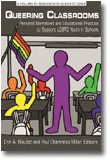
Queering Classrooms
Personal Narratives and Educational Practices to Support LGBTQ Youth in Schools
Edited by:
Erin A. Mikulec, Illinois State University
Paul Chamness Iida
A volume in the series: Research in Queer Studies. Editor(s): Hidehiro Endo, Akita International University.
Published 2016
Teacher Education programs have largely ignored the needs of LGBTIQ learners in their preparation of pre‐service teachers. At best in most of such programs, their needs are addressed in a single chapter in a book or as the topic of discussion in a single class discussion. However, is this minimal discussion enough? What kind of impact does this approach have on future teachers and their future learners?
This book engages the reader in a dialogue about why teacher education must address LGBTIQ issues more openly and why teacher education programs should revise their curriculum to more fully integrate the needs of LGBTIQ learners throughout their curriculum, rather than treat such issues as a single, isolated topic in an insignificant manner. Through personal narratives, research, and conceptual chapters, this volume also examines the different ways in which queer youth are present or invisible in schools, the struggles they face, and how teachers can be better prepared to reach them as they should any student, and to make them more visible. The authors of this volume provide insight into the needs of future teachers with the aim of bringing about change in how teacher education programs address LGBTIQ needs to better equip those entering the field of teaching.
CONTENTS
Introduction: Challenging the Status Quo: Transforming and Queering Education, Erin Mikulec and Paul Chamness Miller. SECTION I: LGBTQ YOUTH AND EDUCATION: HOW FAR HAVE WE COME? A Place Where They Can be Themselves: Issues of LGBTQ Students [Revisited], Michelle L. Knaier. Situating Ally Identities in Relational Epistemes: Learning with LGBTIQ People in Order to Make Supportive and Inclusive Decisions, Ryan Schey. Constructions of Children and CHILDHOOD: IMPLICATIONS FOR LGBTIQ‐INCLUSION AND TEACHER PREPARATION PROGRAMS, CORINNE WICKENS. SECTION II: REFLECTIONS ON PREPARATION: VOICES FROM PRE‐SERVICE AND PRACTICING TEACHERS. Hope for a Better Tomorrow: A Personal Narrative on The Need for Acceptance in Teacher Education Programs, Angela M. Jaime and Brody C. Tate. Advocacy from Adversity: Sculpting an LGBT‐Identity in Art Education, Jordan DeWilde. Preparing to Enter the Field: Reflections from Pre‐Service Teachers on Learning to Work with LGBTQ Youth, Nora Dunne, Kevin Goffard and Jackie Svetich. SECTION III: USING LITERATURE TO ADDRESS ISSUES OF LGBTQ YOUTH IN SCHOOLS: FROM THE CLASSROOM TO THE LIBRARY. Reading Them In: Using LGBT Child and Young Adult Literature in Pre‐service Teacher Education, Paul Venzo. “You don’t have to think about it in that way:” Deconstructing teacher assumptions about LGBTIQ students, Elizabeth Dinkins and Patrick Englert. Teaching Tolerance through Literature: How Including LGBTIQ Titles in Your Library Can Increase Acceptance, Tiffany Renee Droege. SECTION IV: K‐20: CREATING A SAFE AND POSITIVE LEARNING CLIMATE IN ALL EDUCATIONAL SETTINGS. What Being a GSA Sponsor Has Done for Me and Others, Alexandria Henry. A Call to Action: The Importance of School Climate, Professional Development, and Teacher Education Programs in Fostering LGBT Supportive Educators, Melissa Doellman. In Our Own Voice: Campus Climate as a Mediating Factor in the Persistence of LGBT Students, Faculty, and Staff in Higher Education, Warren J. Blumenfeld, Genevieve N. Weber, and Sue Rankin. Conclusion: Tying it All Together: Making Meaning and a Call to Action, Paul Chamness Miller and Erin Mikulec. About the Editors. About the Contributors.
-
Paperback9781681236506
Web price: $45.04 (Reg. 52.99)
-
Hardcover9781681236513
Web price: $80.74 (Reg. 94.99)
- eBook9781681236520

- EDU034000 - EDUCATION: EDUCATIONAL POLICY & REFORM: General
- SOC012000 - SOCIAL SCIENCE: Gay Studies
- SOC028000 - SOCIAL SCIENCE: Women's Studies
-
 Exploring Gender and LGBTQ Issues in K-12 and Teacher Education
A Rainbow Assemblage
Exploring Gender and LGBTQ Issues in K-12 and Teacher Education
A Rainbow Assemblage
-
 Negotiating Spiritual Violence in the Queer Community
Negotiating Spiritual Violence in the Queer Community
-
 Pólvora, sangre y sexo
dialogismos contemporáneos entre la literatura y el cine en América Latina
Pólvora, sangre y sexo
dialogismos contemporáneos entre la literatura y el cine en América Latina
-
 Queer Voices from the Locker Room
Queer Voices from the Locker Room
-
 Queering Education in the Deep South
Queering Education in the Deep South
-
 Queering Public Health and Public Policy in the Deep South
Queering Public Health and Public Policy in the Deep South
-
 Queering Spirituality and Community in the Deep South
Queering Spirituality and Community in the Deep South

